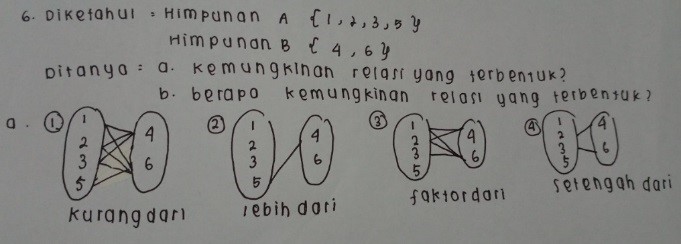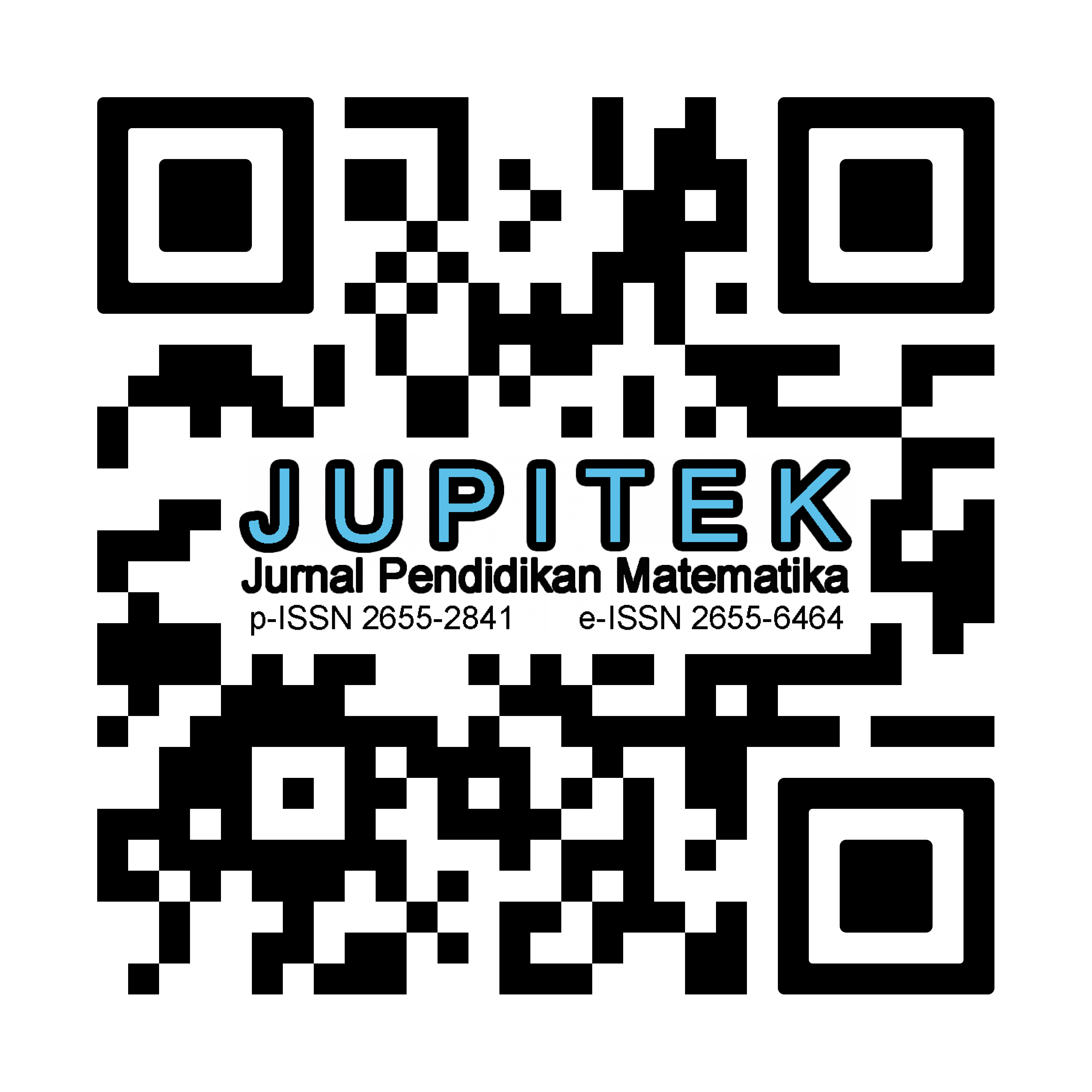ANALISIS KEMAMPUAN BERPIKIR TINGKAT TINGGI SISWA PADA MATERI RELASI DAN FUNGSI KELAS VIII DI SMPN 1 TANJUNGANOM
Abstract
This study aims to determine the students' higher order thinking skills (HOTS) in subject of relation and function. This type of research is a qualitative research with the research subjects being class VIII-1 of SMPN 1 Tanjunganom in the academic year 2020/2021 with a total of 32 students. The data obtained from the HOTS test and interviews. Analysis data used in the form of Bloom's taxonomy analysis. From the results of research conducted by researchers, it shows that the taxonomic percentages of blooms based on each level of C4 (analyze), C5 (evaluate), and C6 (create) are 61.98%, 47.17%, and 48.96%. From the results of the study, the students' HOTS abilities were 1 student in the very good category, 6 students in the good category, 22 students in the sufficient category, 3 students in the poor category, and no students in the very poor category
Downloads
References
Ahmadi, Y. (2016). Analisis Kemampuan Berpikir Kritis Matematis Siswa pada Materi Segitiga. Skripsi. Jakarta: UIN Syarif hidayatullah.
Andini, V., & Warmi, A. (2019). Analisis Tingkat Kemampuan Berpikir Kritis Matematis Siswa SMP Kelas VIII Pada Materi Relasi dan Fungsi. Prosiding Sesiomadika. Universitas Singaperbangsa Karawang.
Budiman, A., & Jailani. (2014). Pengembanagn Instrumen Asesmen Higher Order Thinking Skill (HOTS) Pada Mata Pelajaran Matematika SMP Kelas VIII Semester 1. Jurnal Riser Pendidikan Matematika, Vol. 1 No. 2.
Dinni, H. N. (2018). HOTS (High Order Thinking Skills) dan Kaitannya dengan Kemampuan Literasi Matematika. PRISMA.
Fatimah, S., Muhsetyo, G., & Rahardjo, S. (2019). Proses Berpikir Tingkat Tinggi Siswa SMP Dalam Menyelesaikan Soal PISA dan Scaffoldingnya. JKPM, Vol. 3 No. 1.
Febryanti, & Ahmad, H. (2019). Analisis Pemahaman Konsep Relasi dan Fungsi yang Terintegrasi Nilai-Nilai Islami. Prosiding. SI MaNIs.
Hanifah, R., Noornia, A., & Sampoerno, P. D. (2019). Pengembangan Pembelajaran Dalam Membangun Pemahaman Relasional Siswa Melalui Pendekatan PMRI Materi Relasi Fungsi. Prima: Jurnal Pendidikan Matematika, Vol. 3, No. 2.
Kemdikbud. (2007). Lampiran Peraturan Menteri Pendidikan Nasional. Nomor 16 Tahun 2007 tanggal 4 Mei 2007 Standar Kualifikasi Akademik dan Kompetensi Guru.
Kurniati, D., Harimukti, R., & Jamil, N. A. (2016). Kemampuan Berikir Tingkat Tinggi Siswa SMP Di Kabupaten Jember Dalam Menyelesaikan Soal Berstandar PISA. Jurnal Penelitian dan Evaluasi Pendidikan, Vol. 20, No. 2.
Megawati, Wardani, A. K., & Hartatiana. (2020). Kemampuan Berpikir Tingkat Tinggi Siswa SMP dalam Menyelesaikan Soal Matematika Model PISA. Jurnal Pendidikan Matematika, Vol. 14, No. 1.
Novitasari, D. (2016). Pengaruh Penggunaan Multimedia Interaktif Terhadap Kemampuan Pemahaman Konsep Matematis Siswa. FIBONACCI, Vol. 2, No. 2.
Nurhayati, & Angraeni, L. (2017). Analisis Kemampuan Berpikir Tingkat Tinggi Mahasiswa (Higher Order Thinking) dalam Menyelesaikan Soal Konsep Optika melalui Model Problem Based Learning. JPPPF, Vol. 3, No. 2.
Prasetyani, E., Hartono, Y., & Susanti, E. (2016). Kemampuan Berpikir Tingat Tinggi Siswa Kelas XI dalam Pembelajaran Trigonometri Berbasis Masalah di SMA Negeri 18 Palembang. Jurnal Gantang, Vol. 1, No. 1.
Parhusip, G. D. (2019). Analisis Kemampuan Berpikir Tingkat Tinggi Mahasiswa Program Studi Matematika Angkatan 2018 Kelas C Universitas Sanata Dharma untuk Materi Jarak pada Mata Kuliah Geometri Ruang. Skripsi. Yogyakarta: Universitas Sanata Dharma.
Purbaningrum, K. A. (2017). Kemampuan Berpikir Tingkat Tinggi Siswa SMP dalam Pemecahan Masalah Matematika Ditinjau Dari Gaya Belajar. JPPM, Vol. 10, No. 2.
Rahman, A., Asdar, & Surahman, N. I. (2019). Analisis Keterampilan Berpikir Tingkat Tinggi Siswa dalam Pemecahan Masalah Matematika Berdasarkan Taksonomi Anderson. Issues in Mathematics Education, Vol. 3, No. 2.
Septiana, U., Fatimah, & Suswigi. (2019). Analisis Kemampuan Penalaran Matematik Siswa MTs Pada Materi Relasi dan Fungsi. Journal On Education.
Setiawati, W., Asmira, O., & dkk. (2018). Buku Penilaian Berorientasi Higher Order Thinking Skills. Jakarta: Direktorat Jenderal Guru dan Tenaga Kependidikan.
Suharsimi, A. (2013). Dasar-dasar Evaluasi Pendidikan. Jakarta: Bumi Aksara.
Wahyuddin, & Ihsan, M. (2016). Analisis Kemampuan Menyelesaikan Soal Cerita Matematika Ditinjau dari Kemampuan Verbal pada Siswa Kelas VII SMP Muhammadiyah Se-Kota Makassar. Suska Journal of Mathematics Education, Vol. 2, No. 2.
Yanti, R. N., Melati, A. S., & Zanty, L. S. (2019). Analisis Kemampuan Pemahaman dan Kemampuan Komunikasi Matematis Siswa SMP pada Materi Relasi dan Fungsi. Jurnal Cendekia: Jurnal Pendidikan Matematika, Vol. 3 No. 1.

Copyright (c) 2022 Ninda Sundari Anggraini, Dewi Hamidah, Dwi Shinta Rahayu

This work is licensed under a Creative Commons Attribution-NonCommercial-ShareAlike 4.0 International License.
License and Copyright Agreement
By submitting a manuscript to Jurnal Pendidikan Matematika (JUPITEK), the author(s) certify and agree to the following terms:
- Originality and Authority: The submitting author is authorized by all co-authors to enter into this agreement. The manuscript describes original work that has not been published previously in a peer-reviewed journal, nor is it under consideration for publication elsewhere.
- Approval: Its publication has been approved by all author(s) and by the responsible authorities of the institutions where the work was carried out.
- Rights: The authors secure the right to reproduce any material that has already been published or copyrighted elsewhere.
- Licensing and Copyright: Authors retain the copyright to their work.
- License Grant: The authors grant Jurnal Pendidikan Matematika (JUPITEK) the right of first publication, with the work simultaneously licensed under the Creative Commons Attribution-NonCommercial-ShareAlike 4.0 International (CC BY-NC-SA 4.0).
- Self-Archiving: Authors are permitted and encouraged to deposit the published version of their article in institutional repositories, on their personal websites, and other academic platforms, with proper acknowledgment of its initial publication in Jurnal Pendidikan Matematika (JUPITEK).





.png)


